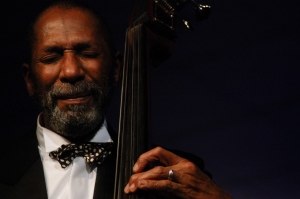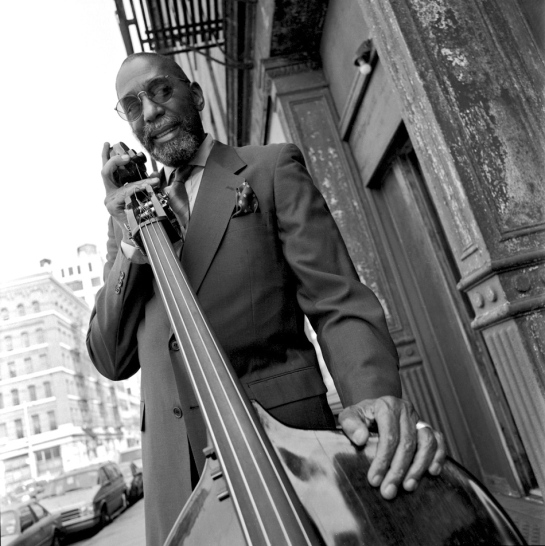“Ron Carter is living proof that integrity and clarity
of artistic vision are alive and well in … jazz.”
John Snyder, Em Arcy
BASSIST
Walk or wander into the world of jazz. Ron Carter is there. His reputation in the
music world is peerless. He stylishly accompanies any player or group and, without
breaking stride, performs with stunning virtuosity as a soloist. His work is rich
in detail, pure in sound, and technically impressive. His long list of accolades as a
performer is unprecedented; he may be the most popular bassist there is.
A lean six feet four inches with a mixture of pride and courtliness, Ron displays an
elegant calm on stage as well as off. He has created music with consummate skill for
more than forty-fi ve years, apparently without rumpling his tasteful suits or raising
a serious sweat. In the early 1960s, he performed throughout the United States in
nightclubs and concert halls with Eric Dolphy, Jaki Byard, and Wes Montgomery, then
toured Europe with Cannonball Adderley. He was a member of Miles Davis’s now
classic quintet from 1963 to 1968, along with Herbie Hancock, Tony Williams, and
Wayne Shorter.

Ron was among the few bassists who continued to play acoustic bass when many
turned to electric bass. “It was a conscious choice,” he says. “I felt a responsibility to
present a viable alternative to the popular electric sound.”
One of Ron’s chief traits is that he creates bass lines so harmonically and rhythmically
rich that soloists must go far to respond to his challenge. As he puts it: “A good bassist
determines the direction of any band.” Often Ron uses gonglike tones and glissandos
in his work. Once his exclusive trademark, these sounds have now become part of
every modern bassist’s vocabulary.
When he first formed his own group, the bass was not generally considered a lead
instrument. Ron found a solution in the piccolo bass, an instrument one-half the size
of a standard bass. He tuned the instrument so as to foster an unusual sound quality,
one that stands out in an ensemble. Backed by a quartet of piano, drums, percussion,
and an additional bass, Ron created one of the most distinctive and unusual jazz
combos ever heard.
COMPOSER/ARRANGER/AUTHOR
Ron Carter won a Grammy award in 1988 for the instrumental composition, Call
Sheet Blues, from the fi lm ‘Round Midnight. He scored and arranged music for a number
of other fi lms including The Passion of Beatrice, directed by Bertrand Tavernier; Haraka,
directed by Ola Balugun; and for the television movies Exit Ten, starring Peter Weller;
and A Gathering of Old Men, starring Richard Widmark and Louis Gossett Jr.
Ron is the author of Building Jazz Bass Lines, a series of books on playing jazz; a
Comprehensive Bass Method, for classical bass studies; Ron Carter, Bass Lines; and The Music
of Ron Carter, which contains 130 of his published and recorded compositions.
Photo by Arthur Elgort
“…his music embodies all the qualities that
make jazz an enduring, vital art form.”
–Stereo Review
To continue reading this article about Ron Carter click this link: RCarterPressKit
of artistic vision are alive and well in … jazz.”
John Snyder, Em Arcy
Walk or wander into the world of jazz. Ron Carter is there. His reputation in the
music world is peerless. He stylishly accompanies any player or group and, without
breaking stride, performs with stunning virtuosity as a soloist. His work is rich
in detail, pure in sound, and technically impressive. His long list of accolades as a
performer is unprecedented; he may be the most popular bassist there is.
A lean six feet four inches with a mixture of pride and courtliness, Ron displays an
elegant calm on stage as well as off. He has created music with consummate skill for
more than forty-fi ve years, apparently without rumpling his tasteful suits or raising
a serious sweat. In the early 1960s, he performed throughout the United States in
nightclubs and concert halls with Eric Dolphy, Jaki Byard, and Wes Montgomery, then
toured Europe with Cannonball Adderley. He was a member of Miles Davis’s now
classic quintet from 1963 to 1968, along with Herbie Hancock, Tony Williams, and
Wayne Shorter.

Ron was among the few bassists who continued to play acoustic bass when many
turned to electric bass. “It was a conscious choice,” he says. “I felt a responsibility to
present a viable alternative to the popular electric sound.”
One of Ron’s chief traits is that he creates bass lines so harmonically and rhythmically
rich that soloists must go far to respond to his challenge. As he puts it: “A good bassist
determines the direction of any band.” Often Ron uses gonglike tones and glissandos
in his work. Once his exclusive trademark, these sounds have now become part of
every modern bassist’s vocabulary.
When he first formed his own group, the bass was not generally considered a lead
instrument. Ron found a solution in the piccolo bass, an instrument one-half the size
of a standard bass. He tuned the instrument so as to foster an unusual sound quality,
one that stands out in an ensemble. Backed by a quartet of piano, drums, percussion,
and an additional bass, Ron created one of the most distinctive and unusual jazz
combos ever heard.
COMPOSER/ARRANGER/AUTHOR
Ron Carter won a Grammy award in 1988 for the instrumental composition, Call
Sheet Blues, from the fi lm ‘Round Midnight. He scored and arranged music for a number
of other fi lms including The Passion of Beatrice, directed by Bertrand Tavernier; Haraka,
directed by Ola Balugun; and for the television movies Exit Ten, starring Peter Weller;
and A Gathering of Old Men, starring Richard Widmark and Louis Gossett Jr.
Ron is the author of Building Jazz Bass Lines, a series of books on playing jazz; a
Comprehensive Bass Method, for classical bass studies; Ron Carter, Bass Lines; and The Music
of Ron Carter, which contains 130 of his published and recorded compositions.
Photo by Arthur Elgort
“…his music embodies all the qualities that
make jazz an enduring, vital art form.”
–Stereo Review



No comments:
Post a Comment